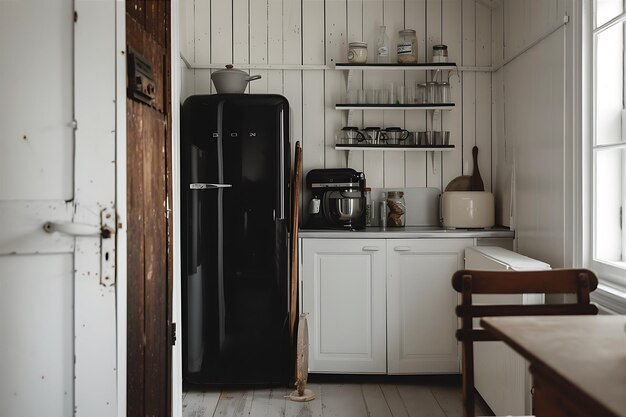Keeping a Refrigerator in Your Garage: What You Need to Know
Storing a refrigerator in your garage might seem like a practical solution, providing extra storage for groceries or beverages. But is it really feasible? Let's unpack the considerations, challenges, and best practices to determine if your garage can house a fridge efficiently.
🏠 Garage Environment and Its Impact on Refrigerators
Temperature Fluctuations
One of the primary challenges of placing a refrigerator in a garage is dealing with temperature variations. Garages are often not climate-controlled, leading to significant temperature fluctuations between seasons. This can be problematic because:
Extreme Heat: In the summer, without proper ventilation, a garage can become exceedingly hot. The refrigerator’s compressor has to work harder to maintain the internal temperature, which could lead to increased energy consumption and potential malfunction.
Bitter Cold: During winter, the unheated environment can cause the fridge’s thermostat not to kick on frequently, leading to spoiled food as the internal temperature might rise above safe food storage levels.
Humidity Levels
Garage environments can also be quite humid or dry compared to home interiors. Excessive moisture can lead to condensation, which may cause rust and electrical issues with a refrigerator. On the flip side, very dry conditions might dry out seals, reducing efficiency.
🤔 Choosing the Right Refrigerator for Your Garage
Types of Refrigerators Suitable for Garages
Not all refrigerators are designed for unconditioned spaces. Here’s how to choose:
Garage-Ready Models: Some manufacturers offer models specifically rated for fluctuating temperatures in garages. These are equipped with better insulation and robust compressors.
Older Model Considerations: Older fridges, particularly those pre-dating energy efficiency standards, might withstand garage environments better due to stronger components and robust construction. However, they are less energy-efficient.
Features to Look For
When selecting a garage refrigerator, consider the following features:
Thermostat Range: Look for models with a broad operational thermostat range to handle varying temperatures.
Robust Insulation: Enhanced insulation helps maintain temperature with less energy.
LED Lighting: Helps with visibility in low-light garage environments.
🛠️ Preparing Your Garage for a Refrigerator
Insulating the Garage
Insulation is key to moderating extreme temperatures. Consider:
Wall and Ceiling Insulation: This can significantly stabilize temperature fluctuations, making it more feasible to keep a fridge running efficiently.
Sealing Gaps: Inspect for any drafts around doors or windows and seal them to prevent outdoor temperature seepage.
Positioning and Ventilation
Positioning and airflow are crucial for the longevity of your garage refrigerator:
Space and Clearance: Allow proper ventilation around the unit; ideally, leave space for airflow on all sides as recommended by the manufacturer.
Away from Sunlight: If sunlight regularly seeps into your garage, keep the refrigerator away to avoid extra heat exposure.
⚡ Energy Efficiency Considerations
Understanding Energy Consumption
A refrigerator’s energy consumption can increase significantly in an uncontrolled environment. Here’s what to monitor:
Electric Bill Fluctuations: Be prepared for possible increases in your electricity bill as your fridge works harder to maintain a steady temperature.
Energy Star Ratings: Opt for models with high-efficiency ratings to mitigate energy usage spikes.
Seasonal Adjustments
Adjustments might be necessary depending on the season:
Summer: Installing a fan to improve air circulation can reduce the fridge's workload.
Winter: A garage heater may be needed to keep the ambient temperature above freezing.
🍖 Food Safety Concerns
Ensuring Safe Food Storage
Maintaining a safe internal environment for your refrigerator is essential for food safety:
Thermometer Use: Regularly use a fridge thermometer to ensure internal temperatures remain consistently below 40°F (4°C).
Organizing Food: Store items like dairy and meats in the coldest sections of the fridge and regularly check for spoilage.
🌟 Essential Takeaways for Garage Refrigeration
Here are key strategies and considerations for maintaining a refrigerator in your garage:
✅ Garage-Ready Models: Invest in refrigerators designed for fluctuating environments if possible.
🔨 Insulation Matters: Properly insulate your garage to stabilize temperatures and ensure efficient refrigerator operation.
🍂 Seasonal Prep: Be ready to adapt to summer and winter challenges by adjusting your setup and possibly adding ventilation or heat.
🕵️ Monitor Safety: Regular temperature checks and food inspections are critical to maintaining both energy efficiency and food safety.
📋 Practical Summary
Key Tips for Keeping a Refrigerator in Your Garage
- 🆕 Choose Wisely: Opt for garage-ready models to handle environmental extremes.
- 🌡️ Manage Temperature: Use insulation and ventilation to moderate garage temperature changes.
- 🔍 Monitor Regularly: Check internal temperatures and food safety to prevent spoilage.
- 💡 Be Flexible: Adjust to seasonal challenges with appropriate ambient solutions like fans or heaters.
Understanding these factors will empower you to make informed decisions about whether to keep a refrigerator in your garage, optimizing for both functionality and efficiency. While not without challenges, careful planning can make this a successful endeavor, providing you with additional convenience and storage without unnecessary risk or expense.
